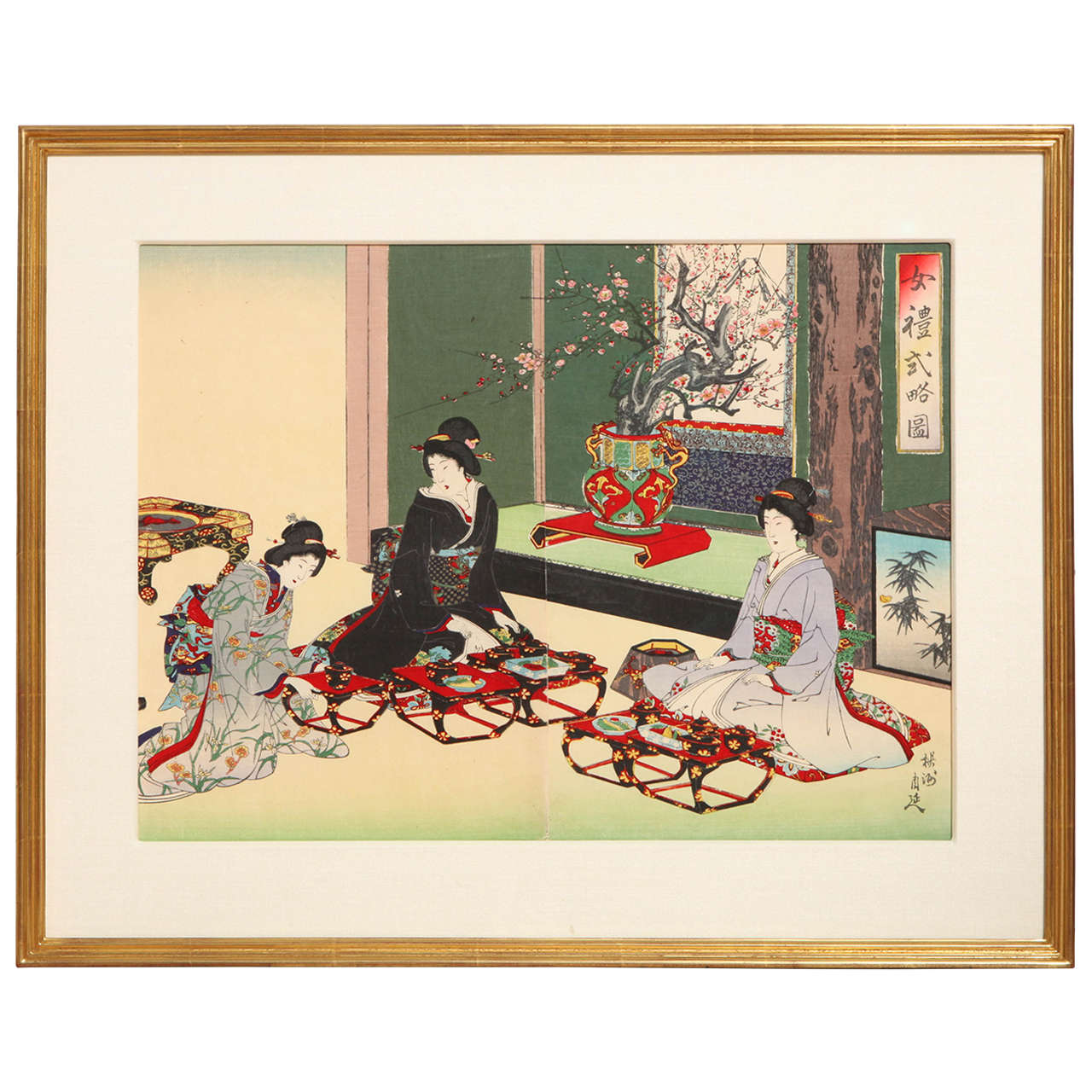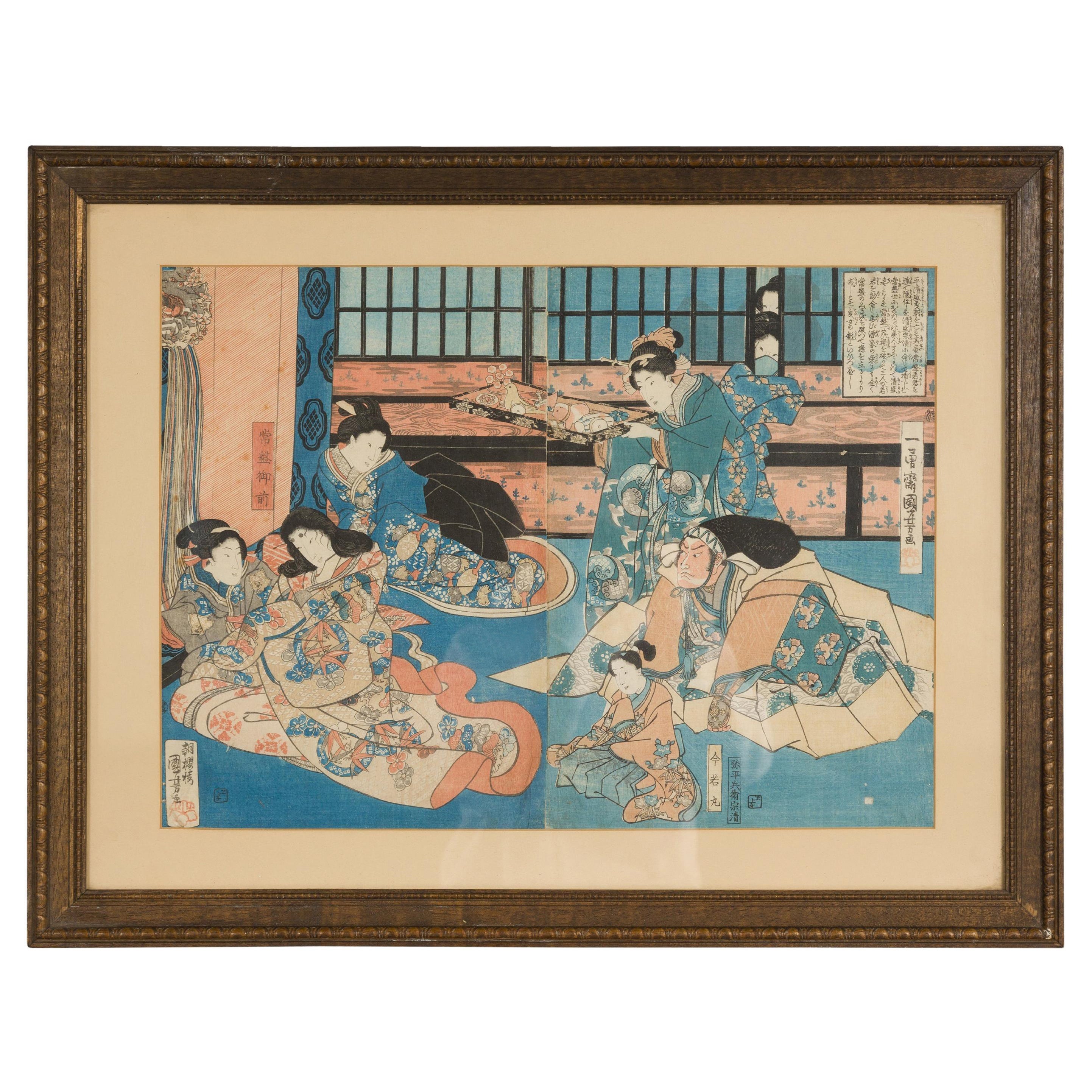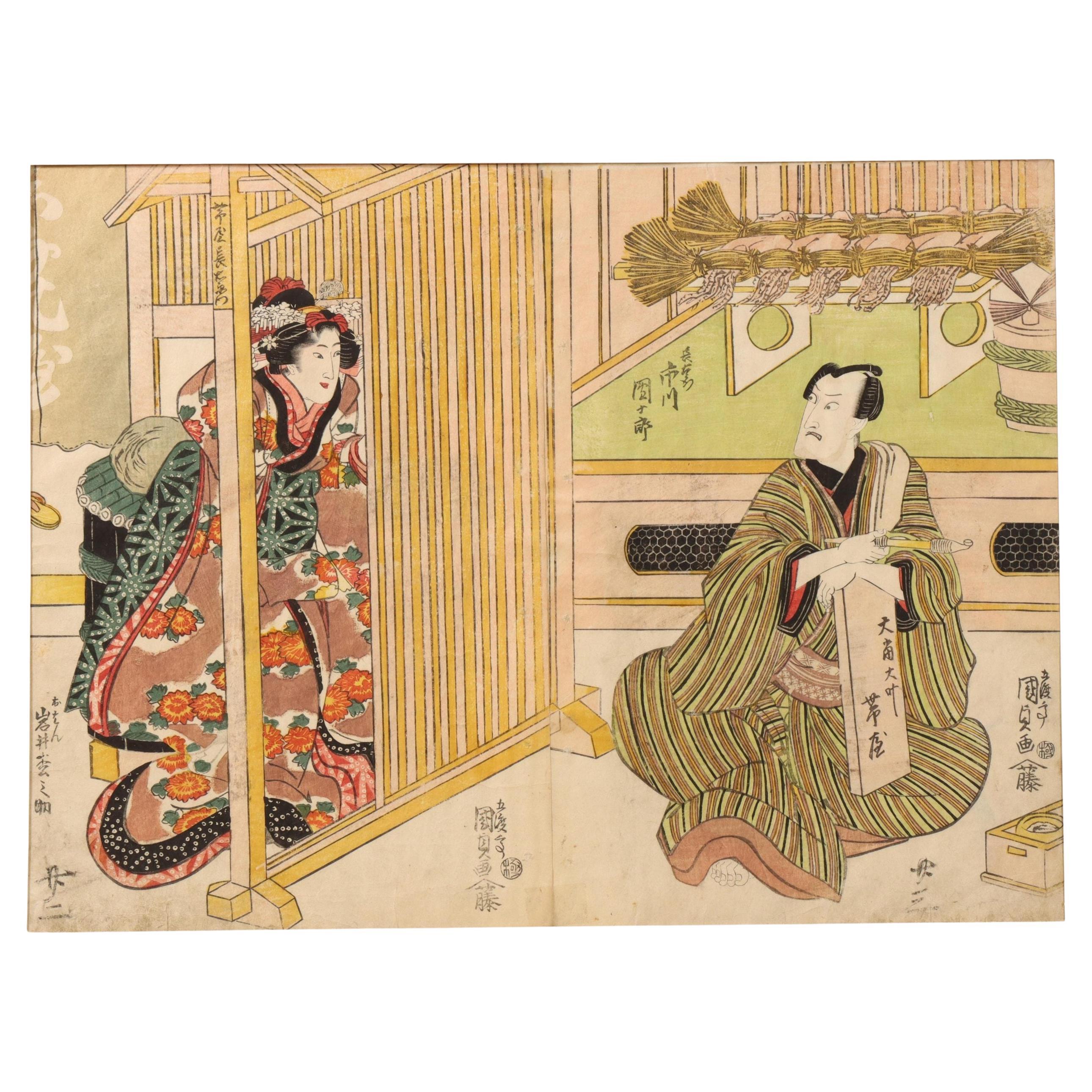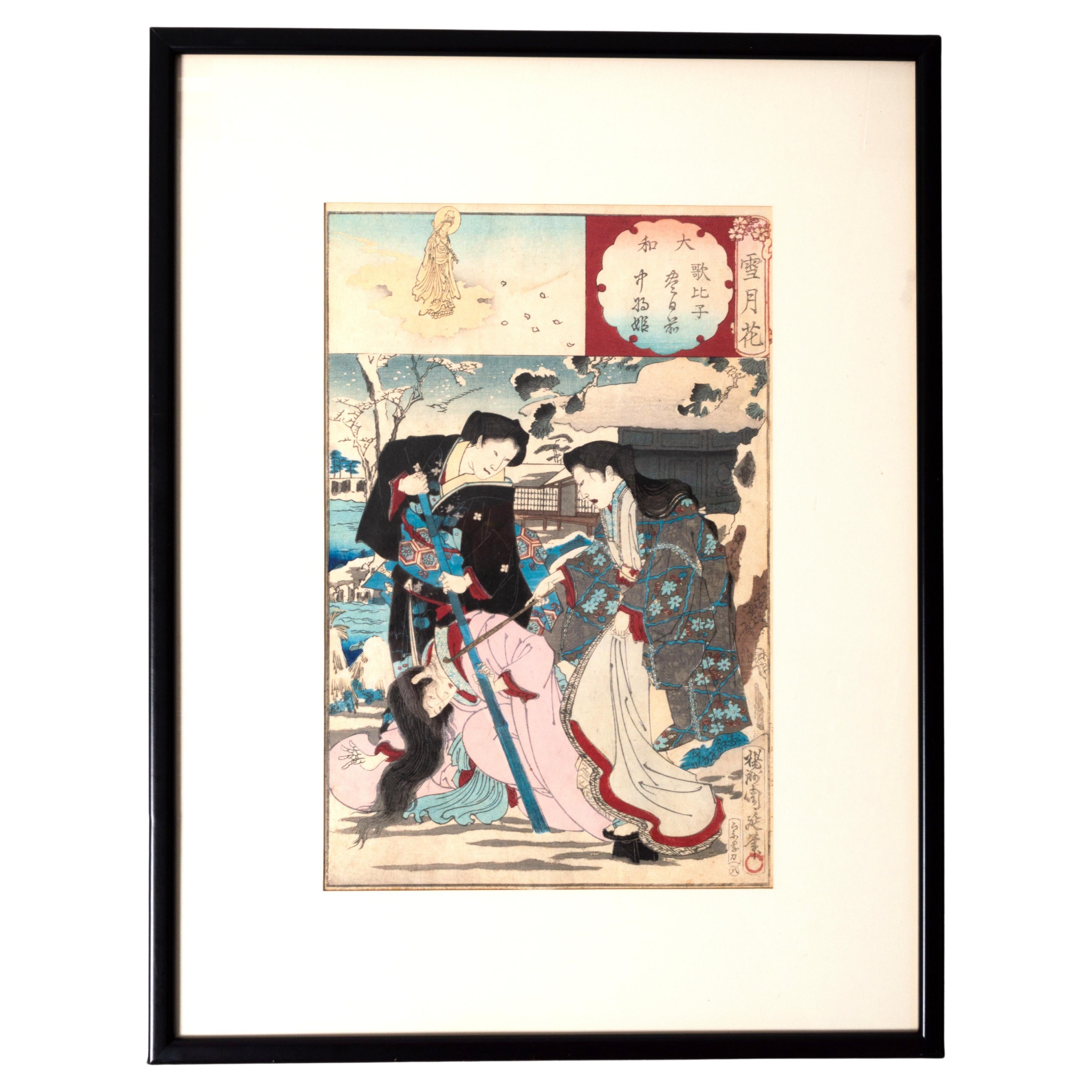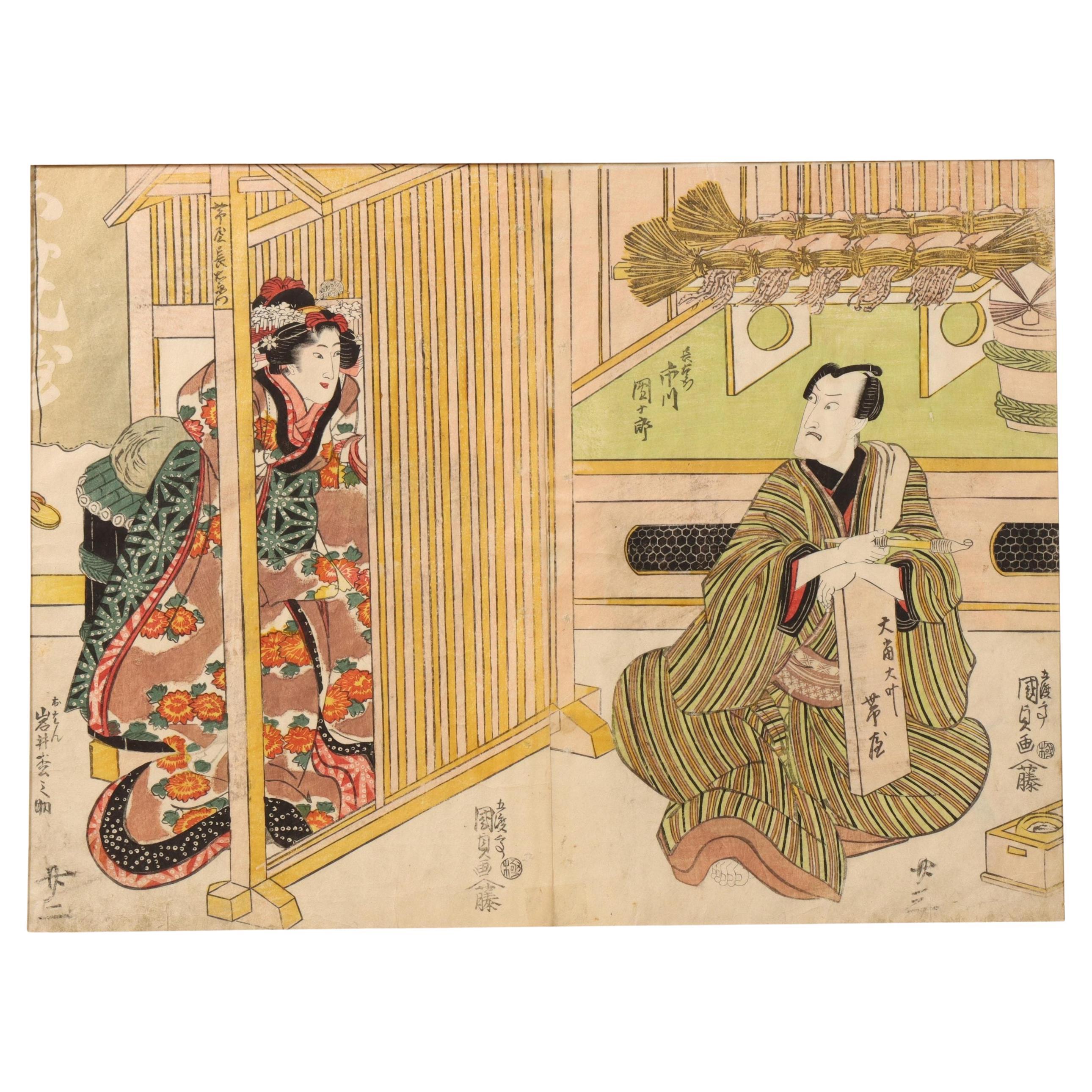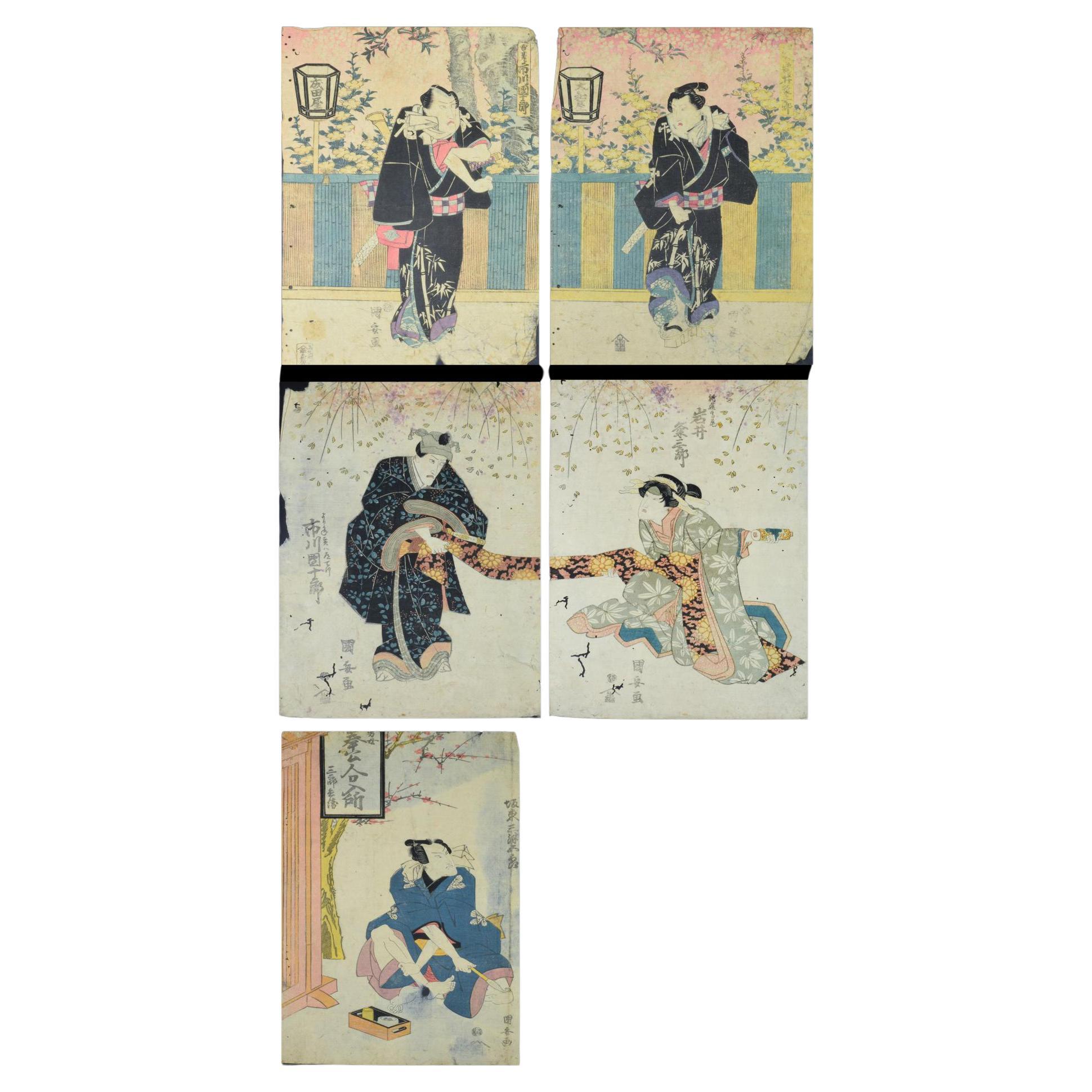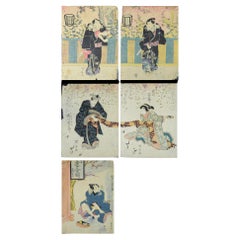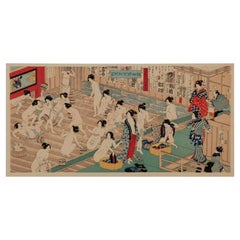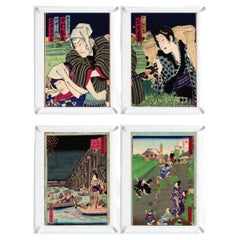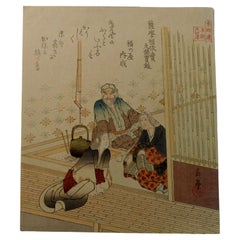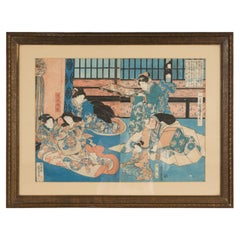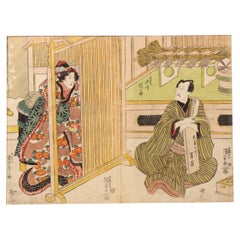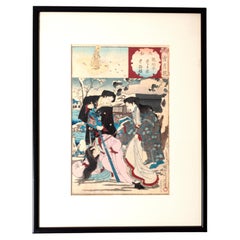Items Similar to Original Japanese Triptych Color Woodblock Print by Toyohara Chikanobu
Want more images or videos?
Request additional images or videos from the seller
1 of 8
Original Japanese Triptych Color Woodblock Print by Toyohara Chikanobu
$3,750
£2,831.66
€3,263.17
CA$5,292.84
A$5,835.24
CHF 3,052.81
MX$71,587.55
NOK 38,428.82
SEK 35,937.02
DKK 24,369.46
About the Item
Original Japanese Triptych Color Woodblock Print by Toyohara Chikanobu
- Title: New Year's Dishes: Etiquette of a Lady
- Publisher: Takekawa Unosuke
Date: Late 19th century
Size: 3 of 9.25" W x 14" H
About the artist
Chikanobu Toyohara (also known as Chikanobu Yoshu) was a leading woodblock print artist of the Meiji Period. Born in Niigata prefecture as Naoyoshi Hashimoto, Chikanobu began his life as the son of samurai in the service of the Sakakibara clan. During the Meiji Restoration, he joined the shogitai, an elite samurai brigade in direct support of the waning Tokugawa Shogunate, and fought bravely in the Battle of Ueno in 1868. Though captured in the fray, he was released unharmed. As the Shogunate fell, Chikanobu focused on a career in art.
Though trained in Kano school painting from an early age, Chikanobu shifted his attention to ukiyo-e around 1852. He began his printmaking career under the tutelage of Utagawa School masters Kuniyoshi, Kunisada and Kunichika. Like many of his contemporaries, Chikanobu Toyohara worked as a newspaper illustrator as well as a print artist. By 1871, he had established himself as a leading print artist. He designed across all genres, from kabuki actors and beauties to military exploits of past and present. During the 1870s, Chikanobu captured Meiji Japan’s rapid modernization through kaika-e, or “enlightenment pictures.” Attuned to current events and public taste, he produced designs of both the 1877 Satsuma Rebellion, an ill-fated insurrection again Meiji government, and well as the 1882 Imo Incident in Korea. Chikanobu’s reflected his changing world not only through his subject matter, but also in his materials. Incorporating the purples and reds of imported aniline dyes, he achieved an element of subtlety and sophistication rarely seen in his era. By the 1880s, a wave of national nostalgia for a Japan past prompted designs exploring traditional Japanese culture, values, and heroes. Through explorations of female beauty, Chikanobu Toyohara personified moments in Japanese history through fashion, manners and customs. In 1912, he died of stomach cancer.
- Dimensions:Height: 14 in (35.56 cm)Width: 9.25 in (23.5 cm)Depth: 0.15 in (3.81 mm)
- Materials and Techniques:
- Place of Origin:
- Period:
- Date of Manufacture:Late 19th Century
- Condition:Wear consistent with age and use.
- Seller Location:Norton, MA
- Reference Number:1stDibs: LU5848234715382
About the Seller
5.0
Gold Seller
Premium sellers maintaining a 4.3+ rating and 24-hour response times
Established in 2000
1stDibs seller since 2021
119 sales on 1stDibs
Typical response time: <1 hour
- ShippingRetrieving quote...Shipping from: Norton, MA
- Return Policy
Authenticity Guarantee
In the unlikely event there’s an issue with an item’s authenticity, contact us within 1 year for a full refund. DetailsMoney-Back Guarantee
If your item is not as described, is damaged in transit, or does not arrive, contact us within 7 days for a full refund. Details24-Hour Cancellation
You have a 24-hour grace period in which to reconsider your purchase, with no questions asked.Vetted Professional Sellers
Our world-class sellers must adhere to strict standards for service and quality, maintaining the integrity of our listings.Price-Match Guarantee
If you find that a seller listed the same item for a lower price elsewhere, we’ll match it.Trusted Global Delivery
Our best-in-class carrier network provides specialized shipping options worldwide, including custom delivery.More From This Seller
View AllJapanese Ukiyo-e Woodblock 'set of 5' by Utagawa Kuniyasu 歌川 国安 , 1794–1832
Located in Norton, MA
Description: Utagawa Kuniyasu (1794-1832), Ukiyo-e Woodblock Print, "Authentic"
Few details are known of Kuniyasu's life. He was born in 1794 and h...
Category
Antique Early 19th Century Japanese Prints
Materials
Paper
Japanese Woodblock Print by Utagawa Yoshiika 落合芳幾 '1833-1904'
Located in Norton, MA
Japanese woodblock print by Utagawa Yoshiika 落合芳幾 (1833-1904), unframed.
About the artist
Yoshiiku was a popular ukiyo-e printmaker during the Meiji period. It is thought that he was the son of a tea house proprietor, hence his particular skill success in the portrayal of various beauties from teahouses and restaurants. Yet, he was an artist comfortable across subject matter and is recognized for his fierce portrayal of famous historical warriors. Yoshiiku was a student of Kuniyoshi and a contemporary rival of the famed Yoshitoshi. He signed his name Utagawa Yoshiiku...
Category
Antique Mid-19th Century Japanese Prints
Materials
Paper
4 Japanese Woodblock Prints 'Double-Side' by Toyohara Kunichika & Shosai Ikkei
Located in Norton, MA
4 Japanese Woodblock Prints (Double-Side) by Toyohara Kunichika (Diptych), and Shosai Ikkei - from Thirty-Six Comics of the Famous Places of Tokyo.
Note: These are only two pieces of woodblock prints with 4 images. They are double-sided with two different prints on each side.
- The video is the purpose for displaying the double-sided image in the acrylic frame, the actual images may be various. I listed many lots for the same artists, but the image will apply to all the lots.
Size:
image: 9.5" x 13.5"
with Frame: 12.75" x 15.75"
About the Artists
- Toyohara Kunichika (Japanese: ?? ??
30 June 1835 – 1 July 1900) was a ukiyo-e Japanese woodblock print artist. Talented as a child, at about thirteen he became a student of Tokyo's then-leading printmaker, Utagawa Kunisada. His deep appreciation and knowledge of kabuki drama...
Category
Antique Mid-19th Century Japanese Prints
Materials
Paper
Japanese Woodblock Gakutei by Harunobu Sugawara-2
Located in Norton, MA
Japanese Woodblock Gakutei (1786-1868) by Harunobu Sugawara, original and unframed.
About the artist
Born in Edo as Harunobu Sugawara, Gakutei Yashima studied printmaking under Shuei and Hokkei. He moved to Osaka in the 1830s, where he designed landscape studies of his new home with a delicate and decorative style likely influenced by Hokusai. In addition to printmaking, he wrote Kyoka (comic poems), often illustrating these verses in his prints. While a talented woodblock artist, Gakutei was also known throughout Japan as a writer. He translated and illustrated the 16th-century Chinese novel Journey to the West...
Category
Antique Early 19th Century Japanese Prints
Materials
Paper
Japanese Woodblock Gakutei by Yashima Gakutei (1786-1868)
Located in Norton, MA
Japanese Woodblock Gakutei (1786-1868) by Harunobu Sugawara, original and unframed.
ABOUT THE ARTIST
Yashima Gakutei (1786-1868)
Born in Edo as Harunobu Sugawara, Gakutei Yashima studied printmaking under Shuei and Hokkei. He moved to Osaka in the 1830s, where he designed landscape studies of his new home with a delicate and decorative style likely influenced by Hokusai. In addition to printmaking, he wrote kyoka (comic poems), often illustrating these verses in his prints. While a talented woodblock artist, Gakutei was also known throughout Japan as a writer. He translated and illustrated the 16th century Chinese novel Journey to the West.
Gakutei Yashima’s oeuvre consists primarily of surimono. These deluxe, limited-edition prints blend the rich visual imagery of ukiyo-e with the ethereal art...
Category
Antique Early 19th Century Japanese Prints
Materials
Paper
Japanese Diptych Woodblock by Morikawa Chikashige 守川周重 Ric.J010
Located in Norton, MA
Japanese Diptych Woodblock by Morikawa Chikashige 守川周重 (Active 1869 - 1882), published in 1881 by Morimoto Junzaburo, framed and glazed.
Dimension: wi...
Category
Antique Early 19th Century Japanese Prints
Materials
Paper
You May Also Like
Japanese Color Woodblock Print by Toyohara Chikanobu
By Toyohara Chikanobu
Located in New York, NY
This Meiji-period color woodblock by Toyohara Chikanobu (1838-1912) depicts three elegant female courtiers in traditional dress taking refreshments. Th...
Category
Antique Late 19th Century Japanese Meiji Prints
Materials
Paper
Japanese Edo 19th Century Signed Utagawa Kuniyoshi Diptych Woodblock Print
Located in Yonkers, NY
An antique Japanese Edo period diptych woodblock print from the early to mid 19th century, signed by Utagawa Kuniyoshi. Immerse yourself in the Japanese Edo period artistry with this antique 19th-century diptych woodblock print. Signed by the artist, this captivating piece is a striking depiction of a tranquil interior scene, rendered in a soothing color palette of blue, pink, and black tones.
This print comprises two panels, assembled under glass in a custom frame to form a cohesive narrative. The scene captures a specific moment in time, presenting a man surrounded by four women and a child, beautifully adorned in traditional Japanese garments. The intricate details of their clothing are a testament to the artisan's skill, bringing an element of authenticity and depth to the scene.
On the left, three women sit in a state of relaxed conversation, while another stands, graciously offering a tray. Adding intrigue, two additional women can be spotted peeking through a slightly open window, one cleverly concealing her face behind a fan. A child, smaller in stature, sits attentively in front of the man, further enhancing the scene's narrative quality.
A signature from the artist adds an additional layer of authenticity, making this piece a must-have for collectors of antique Japanese art...
Category
Antique 19th Century Japanese Edo Prints
Materials
Glass, Paint, Paper
Antique Japanese Woodblock by Utagawa Kunisada I, 19th Century
Located in Amsterdam, Noord Holland
Utagawa Kunisada I (Honjo, Edo 1786-1865 Edo)
Ichikawa Danjuro as Kudo Saemon
Provenance: From the collection of Clemens Merkelbach van Enkhuizen, A well known Dutch painter and art...
Category
Antique 19th Century Japanese Edo Paintings
Materials
Paper
Framed Japanese 19th Century Meiji Woodblock Print By Toyohana Chikanobu
Located in London, GB
Framed Japanese 19th Century Meiji Woodblock Print By Toyohana Chikanobu
Original Woodcut by Chikanobu Toyoharu.(1838 - 1912)
Published in 1884
...
Category
Antique 19th Century Japanese Prints
Materials
Paper
Antique Japanese Woodblock - Utagawa Kunisada I (Honjo, Edo 1786-1865 Edo)
Located in Amsterdam, Noord Holland
Utagawa Kunisada I (Honjo, Edo 1786-1865 Edo),
Diptych,
Ichikawa Danjuro as Kudo Saemon
Provenance: From the collection of Clemens Merkelbach van Enkhuizen, A well known Dutch pain...
Category
Antique 19th Century Chinese Meiji Paintings and Screens
Materials
Bronze
$1,677 Sale Price
20% Off
Framed Japanese 19th Century Diptych Woodblock Print Toyokuni II
Located in London, GB
Framed Japanese 19th Century Diptych Woodblock Print Toyokuni II
Toyokuni II (1786-1864)
"Courtesan Tamagiku and master of the Naka Manjiya House"
Pu...
Category
Antique 19th Century Japanese Prints
Materials
Paper
More Ways To Browse
Woodblock Japan
Japanese Samurai Art
Antique Triptych
19th Century Japanese Woodblock
Kano School
Meiji Samurai
Antique Stomacher
Japanese Woodblock Triptych
Woodblock Triptych
Asian Triptych
Kano Chikanobu
Woodblock Prints Paul
Japanese Woodblock Triptych
Japanese Woodblock Couple
Woodblock Kyoto
Asian Nude
Kyoto Saito
Wood Block Print
